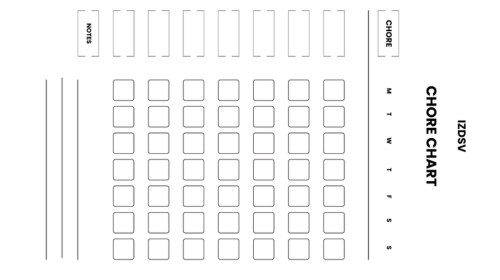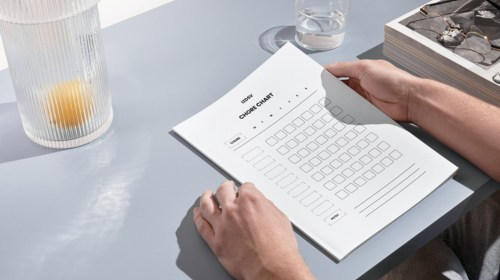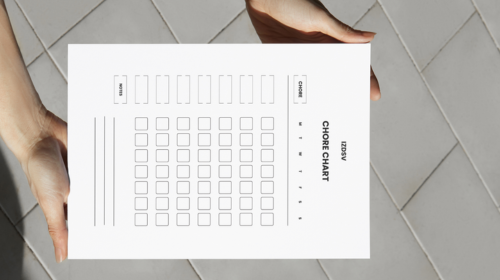Transform Your Parenting with a Reward System Chore Chart for Kids
What is a Chore Chart and How Does It Work?
A chore chart is a visual system designed to organize and track household tasks for family members. It typically displays assigned responsibilities with names, tasks, frequencies, and sometimes rewards or incentives.
- A chart that clearly outlines who is responsible for which household tasks
- Usually organized in a grid format with names and chores
- Can be customized for digital or physical display (whiteboard, poster, app)
- Often includes checkboxes or spaces to mark when tasks are completed
- Works by creating accountability and clear expectations
- May incorporate reward systems like allowance or privileges
Understanding the Basics of a Chore Chart
Chore charts function as organizational tools that help distribute household responsibilities fairly among family members. The most effective charts are simple to understand, accessible to everyone in the household, and incorporate consistent checking and accountability measures.
- Clearly defined tasks with specific descriptions
- Assigned responsibilities matched to age-appropriate abilities
- Regular schedule (daily, weekly, or monthly tasks)
- Visual indicators for completion status
- Rotation system to ensure fairness (optional)
- Consequences or rewards tied to completion
- Consistent enforcement and follow-through
- Periodic reviews to adjust as needed
Types of Chore Charts for Kids
Chore charts for children come in many varieties, designed to accommodate different ages, developmental stages, and family preferences. These can range from simple picture-based systems for young children to sophisticated digital apps for teenagers.
- Picture-based charts for non-readers with visual task representations
- Magnetic board systems with movable task magnets
- Color-coded charts organized by person or room
- Digital apps with notifications and tracking features
- Reward-based systems with stickers or points
- Daily checklist formats for regular routines
- Weekly rotation charts for shared responsibilities
- Responsibility levels that increase with age
- Theme-based charts featuring favorite characters or interests
Benefits of Implementing a Chore Chart
Implementing a chore chart creates structure and teaches responsibility while distributing household work more evenly among family members. Beyond just getting tasks done, chore charts help develop important life skills and family cooperation.
- Teaches responsibility and accountability
- Builds important life skills and work ethic
- Creates clearer expectations for everyone
- Reduces parental nagging and reminders
- Fosters independence and self-reliance
- Provides structure and routine
- Develops time management skills
- Creates a more equitable distribution of household labor
- Can reduce family conflicts over responsibilities
- Offers opportunities to earn rewards or an allowance
- Prepares children for adult responsibilities
- Creates a cleaner, more organized home environment
How to Create an Effective Reward System Chore Chart?
Creating an effective reward system chore chart involves balancing motivational incentives with clear expectations about responsibilities. The most successful systems align rewards with your family values while making the process engaging enough to maintain consistent participation.
- Start with age-appropriate chores that match each child’s abilities
- Clearly define what constitutes task completion
- Create visible, attractive charts that can be prominently displayed
- Establish consistent rewards that are meaningful to your children
- Set reasonable timeframes for task completion (daily/weekly)
- Include a mix of individual and family-oriented rewards
- Consider tiered rewards for basic vs. extra chores
- Balance intrinsic motivation with external rewards
- Start simple and add complexity as the system becomes routine
- Include children in the chart creation process for better buy-in
- Be consistent with checking and rewarding completed tasks
- Periodically review and adjust the system as needed
Choosing the Right Template for Your Family
The ideal chore chart template should reflect your family’s specific needs, living situation, and the ages of your children. Your chosen format should be easy to maintain and update while remaining visually appealing and accessible to everyone involved.
- Digital templates: apps, spreadsheets, or printable downloads
- Physical options: whiteboards, cork boards, magnetic boards, or laminated paper
- Visual designs: calendars, grids, or checklist formats
- Picture-based templates for younger children
- Text-based templates for older children and teens
- Color-coded systems by person, room, or task type
- Customizable templates that allow for easy changes
- All-in-one systems that include both tasks and rewards
- Templates with space for tracking progress over time
- Simple designs for families new to chore charts
- More detailed options for experienced chore chart users
Incorporating a Point System for Chores
A point system adds an element of flexibility and fairness to chore charts by assigning different values to tasks based on difficulty, time required, or importance. This approach allows children to understand the relative value of different responsibilities while providing clear metrics for earning rewards.
- Assign point values based on difficulty, time, or importance of each task
- Create a clear point-to-reward conversion system (e.g., 10 points = $1)
- Consider bonus points for tasks done exceptionally well or without reminders
- Allow point banking for larger rewards or privileges
- Set minimum weekly point requirements for baseline privileges
- Implement tiered rewards at different point thresholds
- Include a mix of small, frequent rewards and larger milestone rewards
- Consider point multipliers for challenging tasks or busy household periods
- Allow children to trade points for immediate rewards or save for larger ones
- Create a visual tracker for accumulated points
- Consider family competition or cooperation point goals
- Adjust point values periodically based on changing abilities and needs
Customizing Your Chore Chart for Kids
Personalizing chore charts to match your children’s interests, developmental stages, and personalities significantly increases engagement and effectiveness. Custom elements make the system more appealing while addressing the specific needs of your household.
- Incorporate favorite characters, colors, or themes
- Add photographs of completed tasks as visual guides
- Include personal motivators specific to each child
- Allow children to help design their own charts
- Adjust complexity based on age and abilities
- Create special sections for rotating or seasonal chores
- Include visual progress indicators like thermometers or path markers
- Add personalized reward menus for each child
- Consider built-in levels or “promotions” as children master responsibilities
- Include space for positive feedback or encouragement
- Create special challenges or bonus opportunities
- Adapt the system as children grow and develop new capabilities
What Are the Best Reward Ideas for Kids?
Effective rewards for children balance meaningful incentives with opportunities for growth and bonding. The most successful reward systems include a mix of tangible items, special privileges, quality time, and recognition of achievements.
- Small toys or collectibles (stickers, trading cards, small figures)
- Screen time or digital privileges (extra video game time, movie night)
- Special outings (trip to the park, zoo, museum, or favorite restaurant)
- One-on-one time with parents (baking together, playing a game)
- Later bedtime for special occasions
- Choosing a family meal or activity
- Small amounts of money or allowance
- Books or educational items of interest
- Craft supplies or creative materials
- Special responsibility privileges (feeding pets, helping cook dinner)
- Sleepovers or playdates with friends
- Recognition certificates or badges
- Small sweet treats (in moderation)
- Choosing the music for car rides
- Special seat at dinner or family movie night
Creating a Reward Chart for Kids
A well-designed reward chart provides clear visual tracking of progress while keeping children motivated to continue positive behaviors. Effective charts are age-appropriate, visually appealing, and structured to provide both short-term wins and longer-term goals.
- Choose a visually appealing theme that excites your child
- Create a clear tracking system (stickers, stamps, checkmarks)
- Set achievable milestones with increasing rewards
- Include a mix of daily and weekly reward opportunities
- Make the chart accessible at the child’s eye level
- Use pictures for younger children who can’t read
- Include a “rewards menu” showing what can be earned
- Consider a progress path design (stepping stones, climbing a mountain)
- Use bright colors and attractive visuals
- Include space for special achievements or bonus tasks
- Create a consistent checking routine (morning/evening)
- Consider themed rewards that match the chart design
- Include a clear explanation of how the chart works
- Make sure rewards are delivered promptly when earned
- Allow for some flexibility while maintaining consistency
Incentives That Motivate Good Behavior
The most powerful behavioral incentives tap into children’s natural desire for recognition, autonomy, and mastery while reinforcing family values. Effective motivation systems balance external rewards with opportunities to develop intrinsic motivation over time.
- Praise and positive reinforcement (specific and genuine)
- Earning special privileges or responsibilities
- Token economies (earning points/tickets for desired items)
- Choice-based rewards (choosing from a menu of options)
- Recognition in front of family members or friends
- Progressive challenge systems (leveling up responsibilities)
- Earning special time with parents or favorite relatives
- Working toward family celebrations or activities
- Collection-based incentives (completing sets of stickers/tokens)
- Surprise rewards for consistent effort
- Goal-oriented rewards tied to specific achievements
- Experience-based rewards rather than material items
- Natural consequences (learning cause-effect relationships)
- Visual progress tracking (seeing improvement over time)
- Competitive elements for some children (beating previous records)
Using Chore Bucks as a Fun Reward System
Chore bucks function as a family currency system that teaches financial literacy while making household responsibilities more engaging. This play money approach creates tangible rewards that help children understand work-reward relationships and practice decision-making skills.
- Create custom family currency (printed “bucks” with family name/logo)
- Establish clear earning values for different chores and behaviors
- Set up a “store” with items available for purchase with chore bucks
- Include both small, inexpensive items and larger “save up” rewards
- Hold regular “store days” when rewards can be redeemed
- Teach saving by offering interest on unspent chore bucks
- Allow children to earn “raises” as they master responsibilities
- Create special limited-time bonus opportunities
- Consider auction events where kids bid on special prizes
- Include non-material rewards like privileges in the “store”
- Provide a “bank” where chore bucks can be safely stored
- Create special denominations for exceptional performance
- Allow trading or gifting between siblings (optional)
- Consider “family purchases” where children pool resources
- Periodically introduce new items to keep the system fresh
How to Use a Weekly Chore List Effectively?
A weekly chore list creates structure and predictability while ensuring household tasks are completed consistently. Effective implementation requires clear communication, regular review, and consistent follow-through to build lasting habits.
- Create a centrally located, visible display accessible to all family members
- Clearly define what “completion” looks like for each task
- Include specific days for each task rather than vague timeframes
- Balance the workload throughout the week rather than overloading certain days
- Include both individual responsibilities and shared family tasks
- Establish a consistent time for checking task completion
- Build in a quick weekly review session to discuss successes and challenges
- Use simple language that everyone understands
- Include space to mark tasks as completed
- Create a routine for resetting the chart each week
- Consider a weekly family meeting to evaluate and adjust as needed
- Ensure an appropriate balance of tasks among family members
- Include seasonal or occasional tasks in rotation
Designing a Weekly Chore List for Kids
When designing a weekly chore list for children, balancing structure with flexibility helps build both responsibility and autonomy. The most effective lists are age-appropriate, visually engaging, and designed to foster independence rather than requiring constant supervision.
- Match tasks to developmental abilities and physical capabilities
- Use simple icons or images for younger children
- Group similar tasks together (bathroom cleaning, kitchen help, etc.)
- Include a mix of daily maintenance and weekly deeper cleaning tasks
- Create a visual distinction between weekday and weekend responsibilities
- Consider color coding by person, room, or task type
- Include both individual and shared family responsibilities
- Provide estimated time expectations for each task
- Include a clear system for marking completion
- Create space for parent verification if needed
- Consider including a difficulty rating for each task
- Allow some choice in when certain flexible tasks are completed
- Include space for bonus or optional tasks
- Design with durability in mind (lamination, whiteboard, digital)
- Make it visually appealing to increase engagement
Tracking Daily Tasks with a Routine Chart
Daily routine charts complement weekly chore lists by focusing on regular habits that maintain household order and personal responsibility. These visual reminders help establish consistent patterns and reduce the need for parental prompting over time.
- Focus on repeating daily tasks like making beds, clearing dishes, etc.
- Organize tasks in chronological order (morning, after school, evening)
- Keep designs simple and uncluttered for easy reference
- Include visual timers or time estimates for time-sensitive routines
- Use simple checkboxes or movable markers to track completion
- Consider separate charts for morning and evening routines
- Include self-care tasks alongside household responsibilities
- Position charts where the tasks actually occur (bathroom, bedroom)
- Create a visual distinction between weekday and weekend routines
- Include space for tracking streak days or consistency
- Consider digital options with reminders for older children
- Use bright colors and engaging visuals for younger children
- Keep charts at eye level for the intended users
- Include positive reinforcement elements or affirmations
- Consider including a “done for the day” final checkbox
Adapting the Chore List as Kids Grow
As children develop new capabilities and maturity, their chore lists should evolve to reflect their increasing capacity for responsibility. Regular assessment and adjustment of expectations help maintain appropriate challenge while building confidence and skills.
- Reassess the appropriateness of tasks every 6-12 months
- Gradually increase the complexity rather than the quantity of tasks
- Add tasks requiring new skills or tools as abilities develop
- Shift from picture-based to text-based formats as reading improves
- Increase independence by reducing parental oversight
- Transition from immediate rewards to delayed gratification systems
- Add planning and decision-making components for older children
- Incorporate more meaningful contributions to family functioning
- Include more self-monitoring and scheduling autonomy
- Add tasks with greater consequence if missed
- Introduce more flexible scheduling for teenagers
- Include budgeting or financial management tasks for teens
- Create leadership opportunities by assigning supervision of younger siblings
- Introduce tasks with transferable life skills (cooking, laundry, basic repairs)
- Consider increasing allowance or privileges along with responsibilities
What Are the Advantages of a Magnetic Chore Chart for Kids?
Magnetic chore charts offer unique benefits that combine practical functionality with engaging interactive elements that appeal to children. Their physical nature and tactile interaction make them particularly effective for younger children who benefit from hands-on learning experiences.
- A highly visual and tangible system that children can physically interact with
- Easy to update and modify without reprinting or redrawing
- Durable construction stands up to regular handling by children
- Can be placed on refrigerators or other magnetic surfaces for high visibility
- Movable pieces allow for flexible task rotation and assignment changes
- Creates satisfying physical feedback when moving tasks from “to do” to “done”
- Available in numerous pre-made designs or can be customized
- Many include colorful magnets that appeal to children
- No need for consumable supplies like stickers or markers
- Can be reused indefinitely, making them cost-effective over time
- Often include both task and reward magnets in one system
- Physical interaction helps reinforce responsibility and accomplishment
- Portable and can be moved between rooms if needed
- Can be expanded with additional magnets as children grow
- Creates less waste compared to paper-based systems
Flexibility and Ease of Use
Magnetic chore charts excel in adaptability, allowing parents to quickly modify tasks and responsibilities without creating an entirely new system. This flexibility makes them particularly valuable for families with changing schedules or multiple children with evolving capabilities.
- Tasks can be instantly reassigned between family members
- Chore rotations can be implemented by simply moving magnets
- Broken or incomplete tasks can be easily moved to the next day
- No erasing, crossing out, or reprinting required for changes
- Can be quickly reset at the beginning of each week
- Easy to add new tasks or remove completed projects
- Multiple children can interact with the chart simultaneously
- Simple enough for children to update independently
- Works well for non-readers when picture magnets are used
- Can be customized with handwritten or printed magnetic pieces
- Accommodates both routine and occasional tasks
- Easy to implement impromptu reward systems
- Can be adjusted seasonally for changing household needs
- Allows for different layouts and organizational systems
- Parents can quickly review completion status at a glance
Interactive Features of a Magnetic Chore Chart
The interactive elements of magnetic chore charts create an engaging experience that helps children feel ownership over their responsibilities. These tactile features transform chore management from a passive list to an active, participatory system.
- Physical movement of task magnets creates a satisfying completion ritual
- Many include spin wheels or sliding components for additional interaction
- Allows children to sort tasks into categories (morning/evening) physically
- Can incorporate fun magnetic characters or themed designs
- Some feature progressive paths where magnets move toward a goal
- Customizable with photos or personalized magnets
- Can include magnetic timers or countdown elements
- Interactive reward trackers with movable pieces
- Allows for “racing” elements between siblings (who completes first)
- Some designs include magnetic storage pockets for unused pieces
- Can incorporate magnetic dice or spinners for random task assignment
- Movable labels allow for adjusting task descriptions as needed
- Enables creation of multi-step processes with sequential magnets
- Can feature magnetic dry-erase elements for additional notes
- Some include secret pockets or reveal features as motivational elements
Keeping Kids Engaged with Daily Chores
Maintaining children’s interest in household responsibilities requires systems that balance novelty with consistency. Magnetic chore charts offer unique engagement features that help sustain motivation while building important habits.
- Physical interaction increases ownership and investment in the process
- Movement of magnets provides immediate visual feedback on progress
- Bright colors and appealing designs capture attention
- Easy customization allows incorporation of children’s current interests
- Can be updated and refreshed periodically to maintain engagement
- Moving tasks from “to do” to “done” creates a tangible accomplishment
- Works well with reward magnets that accumulate toward goals
- Creates a public display of achievements that builds pride
- Encourages children to check the chart independently
- Can incorporate level-up features as children master certain tasks
- Allows for easy implementation of special challenges or bonus tasks
- Physical presence serves as a constant visual reminder
- Can be paired with timers for creating “beat the clock” games
- Creates natural opportunities for positive reinforcement
- Can incorporate family competition or cooperation elements
How to Implement a Chore Chart for Multiple Kids?
Implementing a chore chart for multiple children requires thoughtful planning that balances fairness with individual capabilities. The most successful multi-child systems account for age differences while creating clear individual accountability and minimizing sibling conflicts.
- Create distinct sections for each child with clear visual separation
- Use color coding to distinguish each child’s responsibilities easily
- Balance the workload appropriately based on age and ability
- Consider rotating certain desirable or undesirable tasks for fairness
- Include both individual responsibilities and shared family chores
- Create clear visual indicators of task ownership
- Use appropriate task complexity for each child’s developmental stage
- Include collaborative tasks that require siblings to work together
- Consider buddy systems, pairing older and younger children
- Include “family responsibility” sections for whole-group tasks
- Implement consistent checking times that work for everyone
- Create clear consequences that can be enforced consistently
- Include reward systems that recognize both individual and group achievements
- Consider competitive elements for motivation (with caution)
- Allow some personalization while maintaining system consistency
Creating a Family Chore Chart That Works
A successful family chore chart balances structure with flexibility while accommodating the unique dynamics of your household. Effective systems establish clear ownership while promoting a sense of shared purpose and family contribution.
- Choose a central, accessible location visible to everyone
- Select a format that accommodates your family size (wall chart, board, digital)
- Include all household members, including parents, to model participation
- Create clear categories for personal, shared, and rotational responsibilities
- Establish consistent routines for checking and updating the chart
- Include regular family meetings to discuss successes and challenges
- Balance fairness with age-appropriate expectations
- Create a system for handling disputes or complaints
- Allow some choice within structured options
- Include space for tracking completion and accountability
- Build in flexibility for schedule changes or special circumstances
- Create a visual appeal that matches your family aesthetic
- Include both daily maintenance and weekly deeper tasks
- Consider seasonal or periodic updates to prevent stagnation
- Ensure the system is simple enough for everyone to understand
Assigning Responsibilities Among Siblings
Distributing chores fairly among siblings requires consideration of each child’s abilities, schedules, and developmental needs. Thoughtful assignment creates opportunities for growth while minimizing comparison and competition between children.
- Match tasks to developmental abilities rather than strictly by age
- Consider each child’s natural strengths and interests
- Create balanced workloads that feel fair to all children
- Include progressive responsibility increases as children demonstrate reliability
- Assign tasks that help develop needed skills or address specific challenges
- Implement rotation systems for highly desirable or undesirable tasks
- Consider school and activity schedules when assigning time-sensitive chores
- Create clear definitions of task completion standards
- Allow some choice within appropriate options
- Consider pairing complementary tasks (one sets the table, and another clears)
- Balance “visible” tasks with behind-the-scenes responsibilities
- Create opportunities for children to develop specialty areas
- Consider personal preferences when appropriate
- Establish clear consequences for incomplete tasks that affect others
- Include regular reassessment as children grow and develop
Encouraging Teamwork with a Group Chart System
Group chart systems foster cooperation and shared responsibility while teaching important collaborative skills. These approaches help children understand how their individual contributions impact the entire family while building stronger sibling relationships.
- Create shared family goals with group rewards when achieved
- Include group tasks that require multiple participants
- Implement “buddy system” chores where siblings work together
- Track whole-family progress toward special activities or outings
- Include teamwork bonus points or incentives
- Create “challenge days” where the family works together on larger projects
- Implement task trade options when approved by both parties
- Include special recognition for helpfulness or assistance
- Create combined responsibility zones (playroom, backyard)
- Design complementary task pairs that must be coordinated
- Include family brainstorming sessions for improving systems
- Create special team-based rewards for successful collaboration
- Implement a “family job jar” for spontaneous teamwork opportunities
- Design visual systems that show how individual tasks contribute to a whole
- Include regular appreciation circles to acknowledge helpful behaviors




